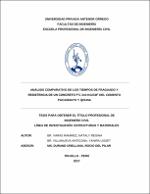| dc.contributor.advisor | Durand Orellana, Rocio del Pilar | |
| dc.contributor.author | Varas Ramirez, Nataly Regina | |
| dc.contributor.author | Villanueva Anticona, Yanira Lisset | |
| dc.creator | Varas Ramirez, Nataly Regina | |
| dc.date.accessioned | 2018-02-07T20:50:55Z | |
| dc.date.available | 2018-02-07T20:50:55Z | |
| dc.date.issued | 2017 | |
| dc.identifier.uri | https://hdl.handle.net/20.500.12759/3597 | |
| dc.description.abstract | En la presente tesis de investigación tuvo como objetivo principal realizar el análisis
comparativo de los tiempos de fraguado y resistencia a la compresión de un
concreto f´c 210 kg/cm 2 del cemento Pacasmayo y Qhuna.
Se llevó diferentes diseños de mezcla de concreto para cada tipo de cemento
portland Tipo I y Ico, ya que cada uno presenta diferentes condiciones químicas y
físicas, pero con diferentes relaciones agua-cemento tales como: 0.40, 0.48 y 0.56
y conservando un slump constante para cada tipo de concreto (Slump: 3″ - 4““).
Logrando de esta manera obtener una consistencia plástica.
Para llegar a cumplir con este objetivo, se tomó como material de esta investigación
las probetas cilíndricas, cuyas dimensiones son de 15 cm x 30 cm y se efectuaron
tres muestras de probetas o testigos de concreto en las cuales se ensayaron a las
edades de 3, 7, 14, 28 días.
También se realizó ensayos de los tiempos de fraguado tanto para cementos
Pacasmayo como Qhuna, estos ensayos fueron realizados en la Universidad
Nacional De Ingeniería, demostrando que el cemento Qhuna es el más adecuado
si se desea un desencofrado rápido, tomando en cuenta los requisitos dados por las
normas ambos logran los requisitos con una relación a/c= 0.40.
Como resultado del proceso de análisis de resistencia a la compresión se logró
conocer la más óptima relación agua cemento debido a que con dicha relación
logramos cubrir todos los porcentajes de dureza de concreto. Esta relación agua
cemento de 0.48, en cementos Pacasmayo a los 28 días cubrió una resistencia de
210 kg/cm
2
sin embargo en cementos Qhuna cubrió una resistencia de 270 kg/cm
a los 28 días de curado.2 | es_PE |
| dc.description.abstract | In this thesis, the main objective of this work was to perform a comparative analysis
of the settling times and compressive strength of a concrete f'c 210 kg / cm2 of the
Pacasmayo and Qhuna cement.
Different concrete mixing designs were used for each type I and Ico portland cement,
since each one presents different chemical and physical conditions, but with different
water-cement ratios such as: 0.40, 0.48 and 0.56 and keeping a constant slump for
each type of concrete (Slump: 3 ““- 4““). This way obtain a plastic consistency.
In order to reach this objective, the cylindrical specimens, whose dimensions were
15 cm x 30 cm,,, were taken as material of this investigation and three samples of
specimens or concrete witnesses were carried out in which they were tested at the
ages of 3, 7, 14, 28 days.
These tests were performed at the Universidad Nacional de Ingeniería,
demonstrating that Qhuna cement is the most suitable if a rapid stripping is desired,
taking into account the requirements given by the standards both meet the
requirements with a ratio a / c = 0.40.
As a result of the process of analysis of compressive strength, it was possible to
know the most optimal ratio of water to cement, because with this relationship we
were able to cover all percentages of concrete hardness. This cement water ratio of
0.48, in Pacasmayo cements at 28 days covered a resistance of 210 kg / cm2
however in Qhuna cements covered a resistance of 270 kg / cm2
at 28 days of curing. | en_US |
| dc.description.uri | Tesis | es_PE |
| dc.format | application/pdf | es_PE |
| dc.language.iso | spa | es_PE |
| dc.publisher | Universidad Privada Antenor Orrego | es_PE |
| dc.relation.ispartofseries | T_ING.CIVIL_1478 | |
| dc.rights | info:eu-repo/semantics/openAccess | es_PE |
| dc.rights.uri | https://creativecommons.org/licenses/by/4.0/ | es_PE |
| dc.source | Universidad Privada Antenor Orrego | es_PE |
| dc.source | Repositorio Institucional - UPAO | es_PE |
| dc.subject | Fraguado y resistencia | es_PE |
| dc.subject | Concreto | es_PE |
| dc.title | Análisis comparativo de los tiempos de fraguado y resistencia de un concreto F´C 210 kg/cm2 del cemento Pacasmayo y Qhuna | es_PE |
| dc.type | info:eu-repo/semantics/bachelorThesis | es_PE |
| thesis.degree.level | Título Profesional | es_PE |
| thesis.degree.grantor | Universidad Privada Antenor Orrego. Facultad de Ingeniería | es_PE |
| thesis.degree.name | Ingeniero Civil | es_PE |
| thesis.degree.discipline | Ingeniería Civil | es_PE |
| dc.subject.ocde | https://purl.org/pe-repo/ocde/ford#2.01.00 | |
| renati.type | https://purl.org/pe-repo/renati/type#tesis | |
| renati.level | https://purl.org/pe-repo/renati/level#tituloProfesional | |
| dc.publisher.country | PE | es_PE |


